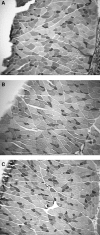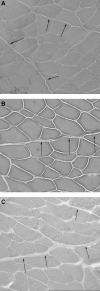Incisional herniation induces decreased abdominal wall compliance via oblique muscle atrophy and fibrosis
- PMID: 17197977
- PMCID: PMC1867936
- DOI: 10.1097/01.sla.0000251267.11012.85
Incisional herniation induces decreased abdominal wall compliance via oblique muscle atrophy and fibrosis
Abstract
Objective: The purpose of this study is to measure abdominal wall myopathic histologic and mechanical changes during incisional herniation and its effect on incisional hernia repairs.
Summary background data: Unloaded skeletal muscles undergo characteristic atrophic changes, including change in fiber type composition, decreased cross-sectional area, and pathologic fibrosis. We hypothesize that these atrophic changes decrease muscle elastic properties and may contribute to the high laparotomy wound failure rate observed following incisional hernia repair.
Methods: A rat model of chronic incisional hernia formation was used. Failing midline laparotomy incisions developed into incisional hernias. Controls were uninjured and sham laparotomy (healed) groups. Internal oblique muscles were harvested for fiber typing, measurement of cross-sectional area, collagen deposition, and mechanical analysis. Mesh hernia repairs were performed on a second group of rats with chronic incisional hernias or acute anterior abdominal wall myofascial defects.
Results: The hernia group developed lateral abdominal wall shortening and oblique muscle atrophy. This was associated with a change in the distribution of oblique muscle fiber types, decreased cross-sectional area, and pathologic fibrosis consistent with myopathic disuse atrophy. These muscles exhibited significant decreased extensibility and increased stiffness. The healed (sham) laparotomy group expressed an intermediate phenotype between the uninjured and hernia groups. Recurrent hernia formation was most frequent in the chronic hernia model, and hernia repairs mechanically disrupted at a lower force compared with nonherniated abdominal walls.
Conclusions: The internal oblique muscles of the abdominal wall express a pattern of changes consistent with those seen in chronically unloaded skeletal muscles. The internal oblique muscles become fibrotic during herniation, reducing abdominal wall compliance and increasing the transfer of load forces to the midline wound at the time of hernia repair.
Figures





Similar articles
-
Reversibility of abdominal wall atrophy and fibrosis after primary or mesh herniorrhaphy.Ann Surg. 2013 Jan;257(1):142-9. doi: 10.1097/SLA.0b013e31825ffd02. Ann Surg. 2013. PMID: 22801088 Free PMC article.
-
Progressive fascial wound failure impairs subsequent abdominal wall repairs: a new animal model of incisional hernia formation.Surgery. 2005 Apr;137(4):463-71. doi: 10.1016/j.surg.2004.12.016. Surgery. 2005. PMID: 15800496
-
Mesh incisional herniorrhaphy increases abdominal wall elastic properties: a mechanism for decreased hernia recurrences in comparison with suture repair.Surgery. 2006 Jul;140(1):14-24. doi: 10.1016/j.surg.2006.01.007. Surgery. 2006. PMID: 16857438
-
Factors involved in abdominal wall closure and subsequent incisional hernia.Surgeon. 2003 Feb;1(1):17-22. doi: 10.1016/s1479-666x(03)80004-5. Surgeon. 2003. PMID: 15568420 Review.
-
Skeletal muscle tissue engineering approaches to abdominal wall hernia repair.Birth Defects Res C Embryo Today. 2008 Dec;84(4):315-21. doi: 10.1002/bdrc.20134. Birth Defects Res C Embryo Today. 2008. PMID: 19067424 Review.
Cited by
-
Transversus Abdominis Muscle Release in Giant Incisional Hernia.Cureus. 2022 Aug 22;14(8):e28277. doi: 10.7759/cureus.28277. eCollection 2022 Aug. Cureus. 2022. PMID: 36039119 Free PMC article.
-
[Loss of domain and reduction in median suture tension].Chirurgie (Heidelb). 2024 Jan;95(1):34-41. doi: 10.1007/s00104-023-01997-5. Epub 2023 Dec 12. Chirurgie (Heidelb). 2024. PMID: 38085298 Review. German.
-
Effects of abdominal surgery through a midline incision on postoperative trunk flexion strength in patients with colorectal cancer.Hernia. 2014 Aug;18(4):487-93. doi: 10.1007/s10029-012-1027-x. Epub 2012 Dec 23. Hernia. 2014. PMID: 23263606
-
Open onlay mesh repair for major abdominal wall hernias with selective use of components separation and fibrin sealant.World J Surg. 2008 Jan;32(1):26-30. doi: 10.1007/s00268-007-9287-9. World J Surg. 2008. PMID: 18026789
-
Pre-operative characteristics and their role in prolonged intubation following abdominal wall reconstruction.Surg Endosc. 2019 Jul;33(7):2345-2348. doi: 10.1007/s00464-018-6536-y. Epub 2018 Oct 17. Surg Endosc. 2019. PMID: 30334163
References
-
- Duepree HJ, Senagore AJ, Delaney CP, et al. Does means of access affect the incidence of small bowel obstruction and ventral hernia after bowel resection? Laparoscopy versus laparotomy. J Am Coll Surgeons. 2003;197:177–181. - PubMed
-
- Santora TA, Roslyn JJ. Incisional hernia. Surg Clin North Am. 1993;73:557–570. - PubMed
-
- Mudge M, Hughes LE. Incisional hernia: a 10 year prospective study of incidence and attitudes. Br J Surg. 1985;72:70–71. - PubMed
-
- Cassar K, Munro A. Surgical treatment of incisional hernia. Br J Surg. 2002;89:534–545. - PubMed
-
- National Center for Health Statistics. Detailed Diagnoses and Procedures: National Hospital Discharge Survey. Washington, DC: National Center for Health Statistics, 1995;13:122.
Publication types
MeSH terms
LinkOut - more resources
Full Text Sources
Other Literature Sources

